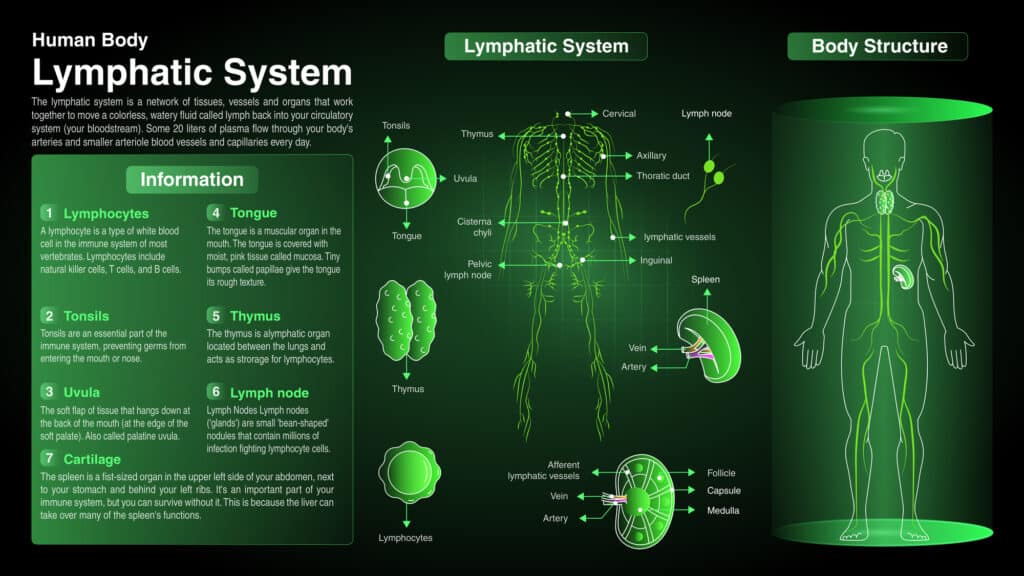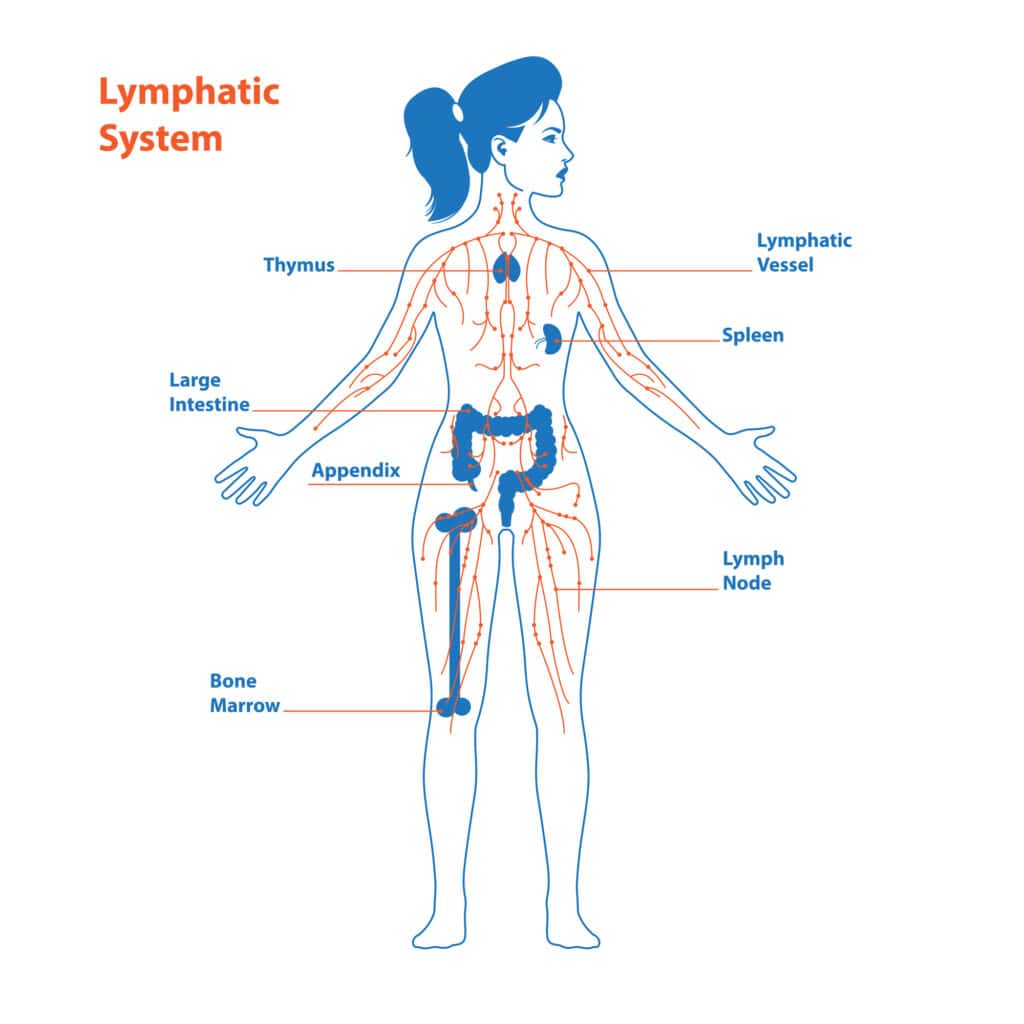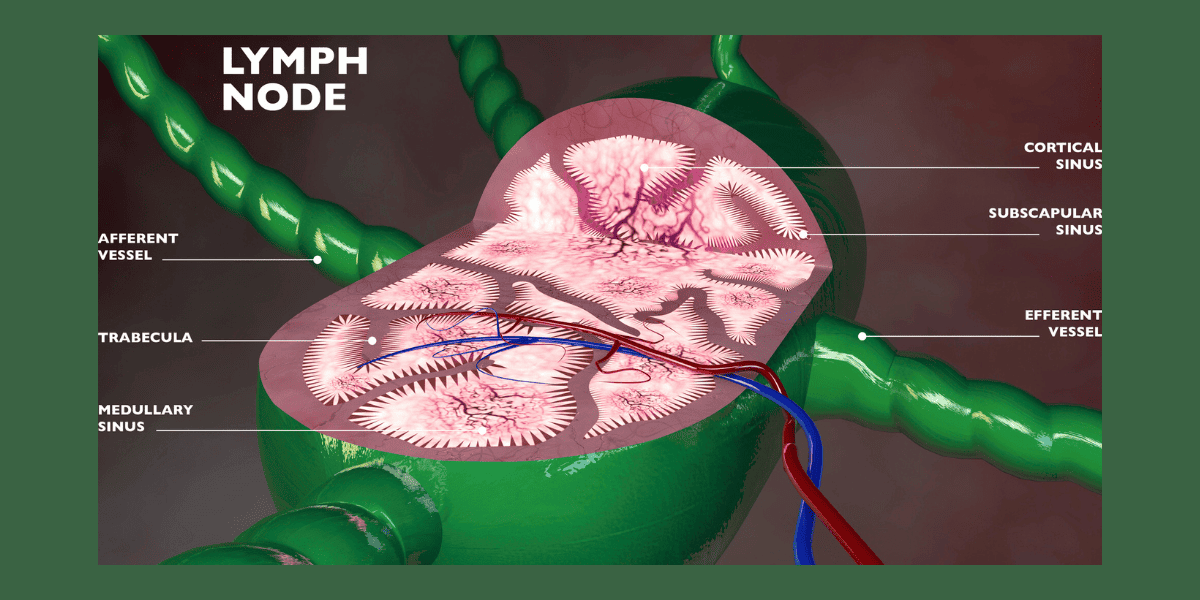“A healthy life depends on the circulation of the lymphatic system. It is our second circulatory system, four times larger than our blood system and the unsung hero of the immune system.”
~ Judy Taylor, educator, author, lymphatic expert
Written by Jennifer Wolff-Gillispie HWP, LC
Edited by Nicki Steinberger, Ph.D.
The lymphatic system is an essential part of human anatomy and physiology, and plays a crucial role in maintaining your overall health. It’s an integral part of the circulatory system, and primarily consists of lymphatic vessels, lymph nodes, tonsils, spleen, and the thymus gland.
It acts as a filtration system, removing waste products, toxins, and foreign substances from your body. It is also responsible for transporting white blood cells, nutrients, and hormones throughout your body. It facilitates immune responses, while maintaining fluid balance.
Fitness expert, Tracy Anderson explains it this way:
“The lymphatic system is quite complex, but on a basic level imagine that it is the main highway for blood flow. It starts with the heart: The heart pumps blood to the arteries, which then passes through the capillaries to the veins and then back to the heart. This is circulation. Every time the blood goes through a passage of this process of circulation, one percent of the volume of the fluid in the blood leaves the artery through the capillary and cannot get back into the vein again. In order for it to get back in, we have a one-way street—the lymphatic system—that picks up the fluid and brings it back to the heart. This traveling process is an adventure in and of itself. It’s critical that this fluid gets back to the heart and that it goes through this system.”
The lymphatic system is responsible for several essential functions:
Balancing fluid: The lymphatic system helps maintain proper fluid balance in the body by collecting excess tissue fluid, known as lymph, and returning it to the bloodstream. Blood loses some of its volume of fluid, as your capillaries are “leaky” (pores in the capillaries allow nutrients and oxygen to exit, and reach cells that need them). About 20 liters of fluid plasma also leaves the capillaries every day, of which about 3 liters are not reabsorbed. It is picked up by the lymphatic system which redeposits it into the circulatory system.
Supporting the immune system: Lymph nodes are hubs for immune cell interaction. They help filter and trap harmful substances, such as bacteria and viruses, and activate immune responses. This is done via macrophages (cells responsible for the destruction of bacteria and other detrimental organisms), dendritic cells (cells responsible for initiating pathogen-specific responses) and lymphocytes (white blood cells tasked with fighting infections and organisms causing disease).
Absorbing fat: The lymphatic system plays a role in absorbing and transporting dietary fats from the digestive system to the bloodstream. The digested fats are encased in protein and salts that aid in their ability to dissolve in water. Because of their size they can not be carried into the capillaries. Instead, they enter through large lymphatic vessels ending up in the veins of the thoracic duct.
Understanding the lymphatic system has been a fascinating quest that spans centuries, and is marked by numerous significant discoveries and advancements. From the vague references in ancient texts to the precise anatomical descriptions and knowledge of functioning we have today, this evolution has been marked by the contributions of countless scientists and researchers.

Ancient Origins
The earliest documented references to lymphatic structures can be traced back to ancient civilizations. Greek and Roman physicians like Hippocrates and Galen, around 400 BC, recognized the existence of lymph nodes, and described them as “gland-like structures” involved in filtering bodily fluids. However, their understanding was limited, and they didn’t grasp the full scope of the lymphatic system’s functions. There are also references in China 2000 years ago describing the circulation of fluids and energy meridians through acupuncture. They believed it to be related to the movement of lymph.
17th century: Thomas Bartholin’s discovery: The lymphatic system’s modern history began to take shape in the 17th century. Danish anatomist Thomas Bartholin is credited with one of the most significant breakthroughs. In 1652, while dissecting a whale, he identified a network of delicate vessels that carried a milky white fluid, which we now know as lymph. He described these vessels in his work, “Historiarum Anatomicarum,” and recognized their presence in humans as well. Bartholin’s discovery laid the foundation for further research into the lymphatic system.
18th century: Lymphatic drainage and filtration: During the 18th century, scientists Johann Nepomuk Röschlaub and Paolo Mascagni made important contributions. Röschlaub conducted experiments to demonstrate that the lymphatic system played a role in the absorption of tissue fluid, and its drainage into the venous system. Mascagni, an Italian anatomist, produced intricate anatomical drawings of the lymphatic system, providing a detailed visual representation of its structure.
19th century: Rudolf Virchow and immune function: The 19th century saw major developments related to the lymphatic system’s immune functions. German pathologist Rudolf Virchow made a profound impact by highlighting the lymphatic system’s role in immunity. He proposed that lymph nodes were essential for immune responses, and could serve as indicators of systemic disease. Virchow’s work connected the lymphatic system to the spread of diseases, and laid the groundwork for understanding its importance in the immune system.
“The lymphatic system’s role in immunity is as vital as the sun is to life on Earth,” he said.
20th century: Cancer and clinical advances: In the 20th century, the lymphatic system’s significance in cancer was recognized. Lymphatic vessels and nodes were observed as routes for the spread of cancer cells. This understanding led to advancements in cancer staging and treatment. Moreover, medical imaging techniques, such as lymphangiography and lymphoscintigraphy, were developed to visualize the lymphatic system. These techniques proved invaluable in diagnosing and treating conditions such as lymphedema, a swelling disorder caused by impaired lymphatic drainage.
21st century: Ongoing research and lymphatic function: Advances in molecular biology and genetics have shed light on the specific mechanisms of lymphatic vessel formation and function. Some recent discoveries regarding the lymphatic system include: The role in healing bone after injury, the ability to produce red and white blood cells, and “emerging evidence of the functional role of cardiac lymphatics in heart development, disease, and repair.” These discoveries have important implications for regenerative medicine, and the treatment of multiple disorders.

To Flow or Not to Flow
Unlike the cardiovascular system that relies on the heart to pump fluid around the body, the lymphatic system relies on you to move your body in order to push lymph throughout. If the lymphatic system is not “manually pumped,” or is inundated with toxins from food, pharmaceuticals, pathogens, or the environment, it can experience stagnation, which can have negative effects on your health.
It’s not an option not to move: A necessary portal to keeping your body healthy is through physical activity. Without daily movement your lymph becomes stagnant, and can pollute your body like a backed-up sewer system. Maimonides, a philosopher and physician from the Middle Ages, understood this and remarked:
“As long as a person exercises and exerts himself…sickness does not befall him and his strength increases…. But one who is idle and does not exercise…even if he eats healthy foods and maintains healthy habits, all his days will be of ailment and his strength will diminish.”
Stagnation occurs when the flow of lymphatic fluid becomes sluggish or obstructed, impeding your system’s ability to cleanse and detoxify effectively. This can lead to a range of symptoms and conditions, including swelling, fatigue, frequent infections, poor immune function, cardiovascular disease, and cancer.
Understanding these potential implications of a poorly functioning lymphatic system is crucial. Once you know, you can identify the symptoms and take steps to correct it. Although not an exhaustive list, below you will find some of the most common indications of lymphatic dysfunction:
- Edema: When the lymphatic system cannot adequately drain excess fluid, it can result in edema. This will cause swelling in various body parts. This condition is common in individuals with lymphedema.
- Infections and immunity: Lymph nodes play a crucial role in the body’s immune responses. Swollen lymph nodes are often a sign of infection. A compromised lymphatic system can weaken the immune system leading to frequent infections and chronic disease.
- Digestive disorders: Impairment of the lymphatic system can lead to malabsorption of dietary fats, causing conditions like chylous ascites (a buildup of fat and lymph fluid in the abdomen).
- Inflammation: Conditions like lymphangitis (inflammation in the lymphatic vessels) and lymphedema are often associated with inflammatory responses due to pathogens, damaged cells, and toxins.
- Cancer: The lymphatic system is a common pathway for the spread of cancer cells. Originating in various parts of the body, these cells are carried to lymph nodes and can metastasize in the lungs.
There are several factors that can lead to lymphatic stagnation. Sedentary lifestyles, lack of exercise, poor diet, chronic stress, and exposure to environmental toxins are among the most common culprits.
Additionally, surgery or trauma, hormonal imbalance, and certain cardiovascular, vasodilator, anti-diabetic, corticosteroid, and chemotherapy medications can also disrupt the flow of lymphatic fluid, resulting in disease. Clearly stated by Michael Edwards in Organic Lifestyle Magazine:
“The lymphatic system removes infections and other toxins from the blood. A sick body is a toxic and infected (or soon to be infected) body. Arguably, most every chronic disease and every infection is indicative of an overwhelmed lymphatic system. When the system is overwhelmed, the body is overwhelmed.”

To maintain a healthy lymphatic system and prevent stagnation, it is important to adopt a set of holistic (mind/body/spirit) practices as part of your lifestyle. Here are some to choose from:
- Exercise: As stated, engaging in regular physical activity is crucial for maintaining optimal lymphatic flow. It improves circulation by accelerating the rate at which lymph drains back into your blood. Exercise stimulates the muscles, which in turn promotes the movement of lymphatic fluid. Activities such as brisk walking, jogging, swimming, yoga, and rebounding on a mini trampoline are particularly beneficial for the lymphatic system.
- Hydration: Drinking an adequate amount of water is essential for the proper functioning of the lymphatic system. Water helps to hydrate the cells and transport nutrients, while also facilitating the removal of waste products. Aim to drink 8–10 glasses of water per day to keep your lymphatic system hydrated and healthy. Sipping hot, purified water every 15 minutes will cleanse your lymphatic system most quickly.
- Dry brushing: Dry brushing involves gently brushing the skin using a natural bristle brush. This technique helps to stimulate lymphatic flow, remove dead skin cells, and unclog the pores. When lymph becomes sluggish, the lymph nodes (which lay under the skin all over the body) can become swollen leading to clogged pores. Begin brushing from your feet upwards, moving in a circular motion. Make sure to avoid sensitive areas, and always brush toward the heart to facilitate lymphatic drainage.
- Nutrition: Consuming a diet rich in organic fruits and vegetables, raw dairy, and pastured, grass fed/finished meats is helpful for supporting lymphatic health. Avoid processed foods, refined sugar/carbohydrates, and trans fats, as they can contribute to inflammation, and hinder lymphatic function. Additionally, including foods with natural diuretic properties, such as organic cucumber, celery, and watermelon, can help reduce fluid retention and support lymphatic flow.
- Herbal medicine: Herbs such as cleavers, red clover, calendula, dandelion, echinacea, and goldenseal have been traditionally used to promote lymphatic drainage. Herbal teas and tinctures can be incorporated into your daily routine to help clear stagnation. Consult with your integrative practitioner to determine any contraindications with pharmaceuticals.
- Stress management: Chronic stress can impair lymphatic function and lead to dysfunction, including adrenal distress. Engaging in stress-reducing activities such as meditation, deep breathing exercises, massage, and yoga, can help keep the lymphatic system functioning optimally. Additionally, allocating ample time to rest daily contributes to stress-reduction.
There’s no sense in waiting for lymphedema or another imbalance to arise before becoming present to the lymph nodes, vessels, and fluid that run through your body. You can begin now to positively influence lymphatic drainage. From “Yoga Poses For Lymphatic Drainage”:
“Many yoga poses can help improve circulation, encouraging the flow of various bodily fluids. Some of these poses can even promote better circulation in the lymphatic system, which means fluid flows freely in the vessels and nodes to its destination. Good circulation is also essential for other reasons, as it allows blood and oxygen to reach your body’s organs to ensure they function properly.”
Remember to get your mini trampoline and get bouncing. This is one of the most effective activities you can do to promote the health of your lymphatic system. From Dr. Axe, “The Benefits of a Trampoline Workout and Rebounding.” Written by wellness educator, Kyra Oliver.
“Rebounding can lead to increased lymph fluid circulation, which helps boost the immune system by providing a greater white blood cell activity. The lymphatic system is part of your circulatory system and transports a clear, colorless fluid, called lymph, that flushes toxins from your body. It’s believed that there is an increase in the circulation of this fluid when the lymphatic valves are opened during a change in gravitational pull.
This particular change occurs upon the moment you land on the trampoline, thanks to gravity. Then, upon leaving the surface, the lymphatic valves are opened.
The increased G-force that occurs when you land causes a surge of lymphatic drainage, which improves circulation and, therefore, may help detoxify your entire system.”
Collectively speaking, the lymph is not typically top-of-mind the way cardiovascular health, reversing type 2 diabetes, and cancer prevention typically are. Since tending to your lymphatic system is a fundamental step toward obtaining and maintaining optimal health, and promoting longevity, now would be the time to tune-in.
~
Published on February 08, 2024.
To contact A Voice For Choice Advocacy, please email media@avoiceforchoice.org.
If you would like to support the research and health education of AVFC editorial, please consider making a donation today. Thank you.

